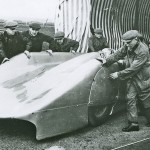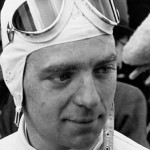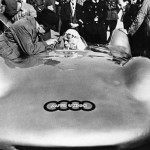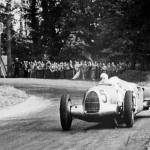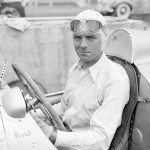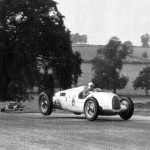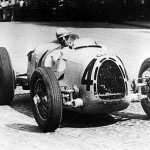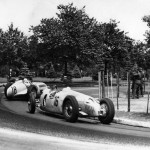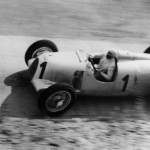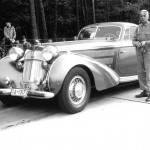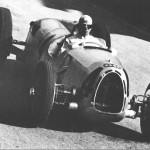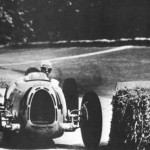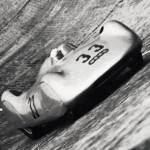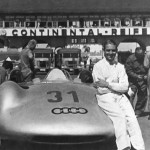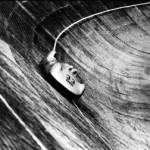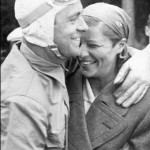October 14: Happy Birthday, Whoever You Were
Bernd Rosemeyer was born 100 years ago this week. We all know the legend of the man who knew no fear, who took the mighty V16 Auto Union grand prix cars and streamliners by the scruff of the neck and hustled them to ten international race victories, a European championship and a succession of world speed records… but who exactly was he?
It is not an easy question to answer, because all that we accepted about the legendary ‘Silver Arrows’ of Auto Union and Mercedes-Benz has been shown to be somewhat wide of the mark. The ties between the fabulous racing cars and the Nazi state that nurtured them have been glossed over, the swastikas painted out of the photographs and the legends re-written to the point where, today, fact and fiction are all-but inextricable.
All of us marvel whenever the Mercedes-Benz museum wheels out its old tigers at Goodwood, Donington or the ‘Ring. We applaud the determination of Auto Union to rebuild its pre-war arsenal of Porsche-designed V16s and later V12s and we all thrill to see them, hear them, smell their ‘special brew’ fuel and retell the old legends. Yet for all that is presented to us we see so little… just as Audi, Porsche and Mercedes would like us to see.
Rather than face any uncomfortable truths, we in the motor sport community long chose to accept what was explained to us. So it was, for example, that the line was swallowed that there was no state funding drive for the German racing cars of 1934-39. We chose to believe that Hitler alone put forward a bounty of 500,000 Reichmarks for the design of the ‘German racing car’ in 1933 and then had to split the figure between two teams rather than one.
Until recently there was no mention of the government funds that totalled up to 40% of the annual budget of both teams, or of the offsetting of budget against orders for new aircraft engines, tanks, staff cars, trucks and the weaponry of war. Nor of the squeeze put on the AvD and ADAC – as Germany’s national motoring clubs – to chip in to the racing fund.
In much the same way we chose to believe that the ‘Silver Arrows’ were born out of necessity as a weight-saving measure in the paddock at the Nürburgring the night before the 1934 Eifelrennen, when their German ‘racing white’ paint was stripped off to get under the 750kg weight limit. The fact is, however, that none of the cars was ever seen at a race meeting in white paint, and that the Eifelrennen was a ‘Formule Libre’ event that didn’t impose a maximum weight limit.
We are told that the drivers themselves (and men like Mercedes-Benz racing manager Alfred Neubauer, or the designers Ferdinand Porsche and Rudolf Uhlenhaut), carried on as if the Third Reich didn’t exist – or if they did notice, they poked fun at it. From the post-war ‘denazification’ hearings onward, the racing men claimed that they only ever joined the Nazi motoring corps, that this was done under duress and that they were never involved with the party or its politics… which is slightly at odds with the facts.
Hermann Lang, the 1939 champion, was a paid-up member of the Nazi party. Having climbed from obscurity to Grand Prix mastery via the shop floor of the factory he fully believed that he could never have become a racing legend without a Nazi government. Thirty years later he remarked: ‘We were proud of it’.
Auto Union’s original star man Hans Stuck is often held up as a paragon of anti-Nazi revolt among the racers. It is true that he was unpopular among the rank and file of Nazis because his wife had a Jewish grandfather – yet after his performances declined and Rosemeyer’s soared, who argued for his reinstatement in the team? None other than SS-Gruppenführer Karl Wolff, acting on behalf of his boss Reichsführer-SS Heinrich Himmler. In effect Himmler bullied Auto Union into keeping Stuck on the squad for the 1938-39 seasons, regardless of his wife’s ancestry.
But when it comes to the SS in motor sport, the name most closely associated with that most sinister order of the Nazi regime is none other than Bernd Rosemeyer. Far the legend of being press-ganged into the motor corps and festooned with unwanted rank as he grew famous, he was in fact a volunteer for the SS – joining in 1932, before Hitler had even come to power.
Sure enough Rosemeyer was promoted within the SS for each of his many achievements – to the point where he died as a Hauptsturmführer or captain. Far from being a ceremonial position, most had to work extremely hard to attain such rank – most notably Josef Mengele, Klaus Barbie and Amon Göth. Yet to her dying day Rosemeyer’s widow Elly Beinhorn repeatedly claimed that her husband never so much as wore the uniform… although unearthed photographs now prove that to be, at best, a mistake on her part.
To me the ‘Silver Arrows’ of the 1930s remain one of the most hypnotic and, yes, heroic stories in the history of motor racing. What was achieved in the workshops of Zwikau and Untertürkheim can never be belittled, nor the raw courage on the track ever underestimated. Yet for too long the very humanity that created the legends has been downplayed, hidden away and ultimately cheapened.
The distortion of time, selected memory and downright lies has given us a picture of Bernd Rosemeyer as a child-like 28-year-old whose only allegiance was to speed. There is no doubt that he was, in a too-brief career, one of the most gifted exponents of the art of driving fast that the world had ever seen. What else either he or his contemporaries may have been is left, for the time being at least, as pure conjecture.
Bernd Rosemeyer – 14 October 1909 – 28 January 1938
International Race Wins
1935 Masaryk GP (Brno, CZ)
1936 Eifelrennen (Nürburgring, D)
1936 German Grand Prix (Nürburgring, D)
1936 Coppa Ciano (Livorno, I)
1936 Coppa Acerbo (Pescara, I)
1936 Swiss GP (Bremgarten, CH)
1936 Italian GP (Monza, I)
1937 Eifelrennen (Nurburgring, D)
1937 Vanderbilt Cup (New York, USA)
1937 Donington GP (Donington Park, UK)
1936 European Grand Prix Champion
1936 German Mountain Champion
International Speed Records
16 June 1937 ‘Flying’ times (set in streamlined car from rolling start)
1 kilometre: 389.610 km/h (242.093 mph)
1 mile: 389.881 km/h (242.261 mph)
5 km: 376.254 km/h (233.794 mph)
5 miles: 368.505 km/h (228.979 mph)
10 km: 357.214 km/h (221.962 mph)
10 miles: 360.279 km/h (233.867 mph) World Record
25 October 1937 ‘Standing’ times (set in Grand Prix car from stationary start)
1 kilometre: 351.906 km/h (218.664 mph)
1 Mile: 353.271 km/h (219.512 mph)
5 km: 346.220 km/h (215.131 mph)
10 km: 334.510 km/h (207.855 mph)
25 October 1937 ‘Flying’ times (set in steamlined car from rolling start)
1 kilometre: 406.321 km/h (252.476 mph)
1 mile: 406.286 km/h (252.454 mph)
26 October 1937 ‘Standing’ times (set in Grand Prix car from stationary start)
1 kilometre: 188.679 km/h (117.240 mph) World Record
1 mile: 216.423 km/h (134.479 mph) World Record
26 October 1937 ‘Flying’ times (set in steamlined car from rolling start)
5 km: 404.585 km/h (251.398 mph)
27 October 1937 ‘Standing’ times (set in streamlined car from a stationary start)
1 Mile: 223.176 km/h (138.675 mph) World Record
27 October 1937 (records set in Grand Prix car)
1 kilometre Standing Start: 169.811 km/h (105.516 mph)
1 mile Standing Start: 199.505 km/h (123.967 mph)
5 km: 346.154 km/h (215.090 mph)
5 miles: 345.106 km/h (214.439 mph)
10 km: 341.621 km/h (212.273 mph)
10 miles: 340.903 km/h (211.827 mph)

